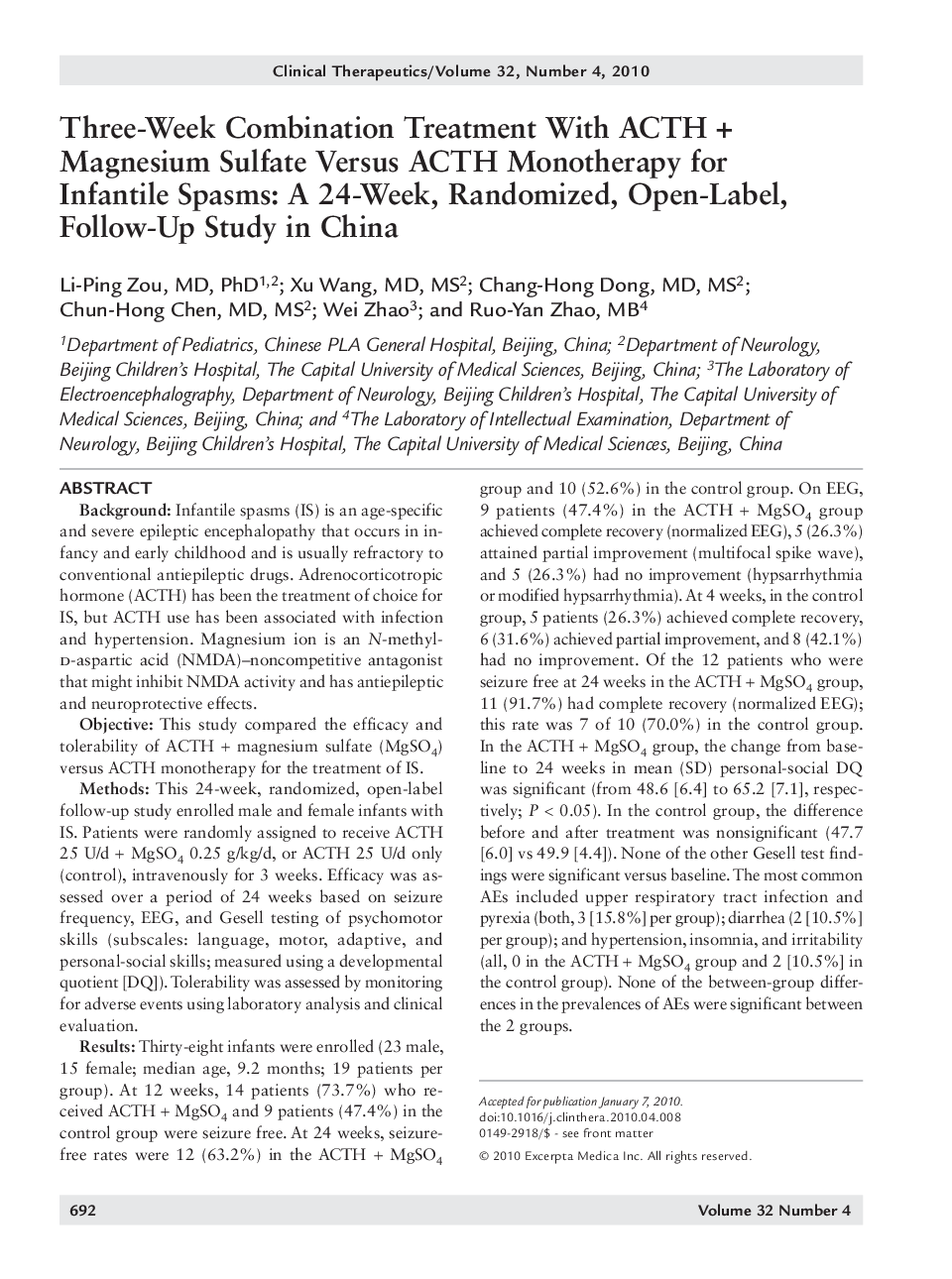| کد مقاله | کد نشریه | سال انتشار | مقاله انگلیسی | نسخه تمام متن |
|---|---|---|---|---|
| 2528868 | 1119990 | 2010 | 9 صفحه PDF | دانلود رایگان |

Background: Infantile spasms (IS) is an age-specific and severe epileptic encephalopathy that occurs in infancy and early childhood and is usually refractory to conventional antiepileptic drugs. Adrenocorticotropic hormone (ACTH) has been the treatment of choice for IS, but ACTH use has been associated with infection and hypertension. Magnesium ion is an N-methyl-D-aspartic acid (NMDA)-noncompetitive antagonist that might inhibit NMDA activity and has antiepileptic and neuroprotective effects.Objective: This study compared the efficacy and tolerability of ACTH + magnesium sulfate (MgS04) versus ACTH monotherapy for the treatment of IS.Methods: This 24-week, randomized, open-label follow-up study enrolled male and female infants with IS. Patients were randomly assigned to receive ACTH 25 U/d + MgS04 0.25 g/kg/d, or ACTH 25 U/d only (control), intravenously for 3 weeks. Efficacy was assessed over a period of 24 weeks based on seizure frequency, EEG, and Gesell testing of psychomotor skills (subscales: language, motor, adaptive, and personal-social skills; measured using a developmental quotient [DQ] ). Tolerability was assessed by monitoring for adverse events using laboratory analysis and clinical evaluation.Results: Thirty-eight infants were enrolled (23 male, 15 female; median age, 9.2 months; 19 patients per group). At 12 weeks, 14 patients (73.7%) who received ACTH + MgS04 and 9 patients (47.4%) in the control group were seizure free. At 24 weeks, seizurefree rates were 12 (63.2%) in the ACTH + MgS04 group and 10 (52.6%) in the control group. On EEG, 9 patients (47.4%) in the ACTH + MgSO4 group achieved complete recovery (normalized EEG), 5 (26.3 %) attained partial improvement (multifocal spike wave), and 5 (26.3%) had no improvement (hypsarrhythmia or modified hypsarrhythmia). At 4 weeks, in the control group, 5 patients (26.3 %) achieved complete recovery, 6 (31.6%) achieved partial improvement, and 8 (42.1%) had no improvement. Of the 12 patients who were seizure free at 24 weeks in the ACTH + MgS04 group, 11 (91.7%) had complete recovery (normalized EEG); this rate was 7 of 10 (70.0%) in the control group. In the ACTH + MgS04 group, the change from baseline to 24 weeks in mean (SD) personal-social DQ was significant (from 48.6 [6.4] to 65.2 [7.1], respectively; P < 0.05). In the control group, the difference before and after treatment was nonsignificant (47.7 [6.0] vs 49.9 [4.4]). None of the other Gesell test findings were significant versus baseline. The most common AEs included upper respiratory tract infection and pyrexia (both, 3 [15.8%] per group); diarrhea (2 [10.5%] per group); and hypertension, insomnia, and irritability (all, 0 in the ACTH + MgS04 group and 2 [10.5%] in the control group). None of the between-group differences in the prevalences of AEs were significant between the 2 groups.Conclusions: In this study in infants with IS, the proportions of patients who were seizure free from 4 to 24 weeks were significantly greater in the ACTH + MgS04 group compared with the ACTH monotherapy group. Personal-social neurodevelopment was significantly improved from baseline in the group that received combination treatment. Both treatments were generally well tolerated.
Journal: Clinical Therapeutics - Volume 32, Issue 4, April 2010, Pages 692-700